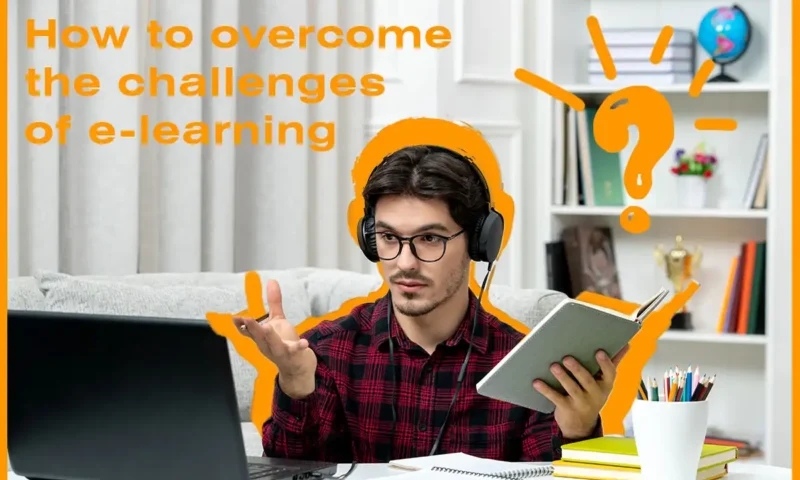
E-learning is a modern and flexible learning method that offers many benefits for learners, educators, and organizations. E-learning can help you access a variety of courses and programs from anywhere and anytime, save time and money, customize your learning pace and style, and enhance your skills and knowledge. However, e-learning is not without its challenges. E-learning can also pose some difficulties and obstacles that can affect your learning outcomes and satisfaction. Some of the common e-learning challenges include:
- Lack of motivation and engagement
- Technical issues and distractions
- Isolation and lack of interaction
- Time management and self-discipline
- Quality and relevance of content
In this article, we will share some tips on how to overcome these challenges and make the most of your e-learning experience. We will also answer some frequently asked questions about e-learning and provide some useful resources and tools to help you along the way.
Also read: Successful Interior Design: tips and resources for beginners (moumentec.com)
What are the challenges of e-learning?
Let’s take a closer look at each of the challenges of e-learning and how they can impact your learning process.
Challenge 1: Lack of motivation and engagement
One of the biggest challenges of e-learning is keeping yourself motivated and engaged throughout the course. Unlike in a traditional classroom setting, where you have a teacher and peers to guide and support you, in e-learning, you are mostly on your own. This can make you feel bored, frustrated, or overwhelmed, especially if the course is too easy or too hard, too long or too short, or not relevant to your needs and goals.
How to overcome it:
- Set clear and realistic learning objectives and track your progress. Having a clear idea of what you want to achieve and how you are doing can help you stay focused and motivated. You can use a project management tool, such as Trello, Asana, or Wrike, to organize your tasks and deadlines, and a learning management system (LMS), such as LearnUpon, to access your courses and monitor your performance.
- Choose courses that interest you and match your level and style. E-learning offers a wide range of courses and programs for different topics, levels, and formats. You can find courses that suit your preferences and needs, whether you want to learn a language, a technical skill, or a professional qualification. You can also choose courses that are interactive, engaging, and fun, such as those that use gamification, storytelling, or multimedia elements.

Reward yourself and celebrate your achievements. Learning online can be challenging, but it can also be rewarding. You can reward yourself for completing a module, a course, or a program, by giving yourself a break, a treat, or a certificate. You can also celebrate your achievements by sharing them with your friends, family, or online community, and receiving feedback and recognition.
Challenge 2: Technical issues and distractions
Another challenge of e-learning is dealing with technical issues and distractions that can interrupt your learning process. Technical issues can include slow internet connection, low battery, software glitches, or compatibility problems. Distractions can include noise, phone calls, social media, or other people. These can affect your concentration, comprehension, and retention of the course material.
How to overcome it:
- Check your device and internet connection before starting the course. Make sure your device is fully charged, updated, and compatible with the course platform and format. Also, make sure your internet connection is stable, fast, and secure. You can use a speed test tool, such as Speedtest, to measure your internet speed and performance.
- Create a comfortable and quiet learning environment. Find a place where you can learn without interruptions and distractions. You can use headphones, earplugs, or white noise to block out any noise. You can also turn off your phone, notifications, and other apps that are not related to the course. You can also inform your family, friends, or colleagues that you are learning online and ask them not to disturb you.
- Take breaks and stretch your body and mind. Learning online can be tiring and stressful, especially if you spend long hours in front of the screen. You can avoid fatigue and boredom by taking regular breaks and doing some physical and mental exercises. You can use a timer tool, such as Pomodoro, to schedule your breaks and work sessions. You can also use a fitness app, such as Fitbit, to track your activity and health.
Challenge 3: Isolation and lack of interaction

A third challenge of e-learning is feeling isolated and disconnected from your instructor and peers. E-learning can be a lonely and solitary experience, especially if you are used to learning in a social and collaborative environment. You may miss the opportunity to ask questions, share ideas, receive feedback, or build relationships with other learners and educators.
How to overcome it:
- Communicate and collaborate with your instructor and peers. E-learning does not mean learning alone. You can still interact and engage with your instructor and peers through various online channels and tools, such as email, chat, video call, forum, or social media. You can ask questions, share resources, exchange opinions, or work on group projects. You can also join online communities and networks related to your course topic or field of interest, such as LinkedIn, Reddit, or Quora.
- Participate and contribute to the course activities and discussions. E-learning can be more interactive and dynamic if you actively participate and contribute to the course activities and discussions. You can complete the assignments, quizzes, surveys, or polls, and provide your feedback and comments. You can also initiate or join the discussions, debates, or brainstorming sessions, and express your views and insights. This can help you enhance your learning outcomes and satisfaction, as well as build your confidence and reputation.
- Seek and offer support and encouragement. E-learning can be challenging and stressful, but you are not alone. You can seek and offer support and encouragement to your instructor and peers, and create a positive and supportive learning environment. You can ask for help, advice, or guidance, and provide your suggestions, tips, or recommendations. You can also acknowledge, appreciate, or compliment your instructor and peers, and celebrate your achievements and successes.
Challenge 4: Time management and self-discipline

A fourth challenge of e-learning is managing your time and maintaining your self-discipline. E-learning can offer you more flexibility and autonomy in your learning schedule and pace, but it also requires more responsibility and commitment from you. You may face difficulties in balancing your learning with your other personal or professional obligations, or in staying on track and meeting your deadlines.
How to overcome it:
- Plan and prioritize your learning tasks and goals. E-learning can be more effective and efficient if you plan and prioritize your learning tasks and goals. You can use a calendar tool, such as Google Calendar, Outlook, or iCal, to create and organize your learning schedule and reminders. You can also use a goal-setting tool, such as SMART, OKR, or GROW, to define and measure your learning outcomes and achievements.
- Set and follow a regular and realistic learning routine. E-learning can be more consistent and productive if you set and follow a regular and realistic learning routine. You can choose a time and place that works best for you and your learning style, whether it is morning or evening, home or office, or quiet or noisy. You can also allocate a specific amount of time and effort for each learning session, and avoid procrastination and multitasking.
- Review and reflect on your learning progress and performance. E-learning can be more rewarding and satisfying if you review and reflect on your learning progress and performance. You can use a journaling tool, such as Evernote, OneNote, or Penzu, to record and organize your learning notes and thoughts. You can also use a feedback tool, such as SurveyMonkey, Typeform, or Google Forms, to collect and analyze your learning feedback and results.
Challenge 5: Quality and relevance of content

A fifth challenge of e-learning is ensuring the quality and relevance of the content that you are learning. E-learning can offer you a vast amount of content and information, but not all of it may be accurate, reliable, or up-to-date. You may also encounter content that is not suitable for your level, style, or purpose, or that does not match your expectations or standards.
How to overcome it:
- Evaluate and verify the source and credibility of the content. E-learning can be more trustworthy and valuable if you evaluate and verify the source and credibility of the content that you are learning. You can use a search engine tool, such as Bing, Google, or DuckDuckGo, to find and compare different sources and information. You can also use a fact-checking tool, such as Snopes, FactCheck, or PolitiFact, to check and confirm the accuracy and validity of the content.
- Select and filter the content that meets your needs and goals. E-learning can be more relevant and meaningful if you select and filter the content that meets your needs and goals. You can use a curation tool, such as Scoop.it, Feedly, or Flipboard, to collect and organize the content that interests you and suits your preferences and objectives. You can also use a personalization tool, such as Coursera, Udemy, or Khan Academy, to access and customize the content that matches your level and style.
- Review and update the content regularly and frequently. E-learning can be more current and fresh if you review and update the content regularly and frequently. You can use a subscription tool, such as RSS, email, or podcast, to receive and follow the latest and most relevant content and information. You can also use a revision tool, such as Quizlet, Anki, or Memrise, to reinforce and refresh your learning and memory.
Conclusion
E-learning can be a great way to learn new skills and knowledge, but it also comes with some challenges that can affect your learning outcomes and satisfaction. In this article, we have shared some tips on how to overcome the challenges of e-learning and make the most of your online learning experience. We hope that these tips will help you enjoy and succeed in your e-learning journey.
Frequently asked questions and their answers
Here are some frequently asked questions and their answers about e-learning and how to overcome its challenges.
What are the benefits of e-learning?
- E-learning can offer many benefits for learners, educators, and organizations, such as:
- Accessibility: You can access a variety of courses and programs from anywhere and anytime, as long as you have a device and an internet connection.
- Affordability: You can save time and money, as you do not have to travel, pay for accommodation, or buy textbooks or materials.
- Flexibility: You can customize your learning pace and style, as you can choose when, where, and how to learn, and adjust your learning according to your needs and goals.
- Diversity: You can enhance your skills and knowledge, as you can learn from different sources, perspectives, and experts, and explore different topics, fields, and cultures.
What are the disadvantages of e-learning?
- E-learning can also have some disadvantages for learners, educators, and organizations, such as:
- Motivation: You may lack motivation and engagement, as you may feel bored, frustrated, or overwhelmed, especially if the course is not interesting, relevant, or suitable for you.
- Technology: You may face technical issues and distractions, as you may have a slow internet connection, a low battery, a software glitch, or a compatibility problem, or you may be interrupted by noise, phone calls, social media, or other people.
- Interaction: You may feel isolated and disconnected, as you may miss the opportunity to interact and collaborate with your instructor and peers, and receive feedback and support.
- Discipline: You may have difficulties in managing your time and maintaining your self-discipline, as you may have to balance your learning with your other personal or professional obligations, or stay on track and meet your deadlines.
- Quality: You may encounter content that is not accurate, reliable, or up-to-date, or that is not suitable for your level, style, or purpose, or that does not match your expectations or standards.
How can I improve my e-learning skills and strategies?
- You can improve your e-learning skills and strategies by following some tips and best practices, such as:
- Set clear and realistic learning objectives and track your progress.
- Choose courses that interest you and match your level and style.
- Reward yourself and celebrate your achievements.
- Check your device and internet connection before starting the course.
- Create a comfortable and quiet learning environment.
- Take breaks and stretch your body and mind.
- Communicate and collaborate with your instructor and peers.
- Participate and contribute to the course activities and discussions.
- Seek and offer support and encouragement.
- Plan and prioritize your learning tasks and goals.
- Set and follow a regular and realistic learning routine.
- Review and reflect on your learning progress and performance.
- Evaluate and verify the source and credibility of the content.
- Select and filter the content that meets your needs and goals.
- Review and update the content regularly and frequently.




